For most people, fraud is a term more often associated with forged cheques or insurance scams than the contents of their kitchen cupboards. In fact, public awareness of food fraud is almost non-existent, despite infamous incidents across the globe. Our readers in Europe, for example, will remember the horse meat lasagne scandal of 2013…
But equine pasta is just the tip of the iceberg. Today’s consumers are faced with hoax honey, counterfeit coffee and bogus booze – amongst countless further imposters, each of which carries economic costs and potential risks to health. To complicate matters further, fraudsters are becoming increasingly sophisticated – in many cases, adulterated or mislabeled foods are not identifiable by appearance or taste.
The task of detecting fraudulent foods has thus fallen to the analytical community. Laboratories across the world are playing the role of detective, piecing together molecular clues to identify the criminals tampering with our food chains. We caught up with the USA’s ultimate defenders of public safety, the Food and Drug Administration (FDA), to explore how we can protect the consumers of tomorrow.

Most readers will be familiar with the FDA, the agency of the United States Department of Health and Human Services concerned with the protection of public health by ensuring the safety of drugs, foods and other biological products.
Food fraud has been a major focus for the agency since its inception, rooted in the work of chemist Harvey Wiley. Harvey joined the US Department of Agriculture as Chief Chemist in 1883, and spent over two decades conducting research into the effects of harmful chemicals in food. This research took the form of standard tests to assess the purity of commercially available products, and human trials to evaluate the effects of chemical preservatives; volunteers for these trials were referred to by the press as Harvey’s “poison squad.” His work laid the foundation for the Pure Food and Drugs Act, signed by President Theodore Roosevelt in 1906 – the FDA was founded that same year.
Today, the FDA is responsible for consumed food, medicine and tobacco totalling a value of over $2.6 trillion (approximately 20 cents of every dollar spent by consumers in the US) (1). They are also responsible for the regulation of 77 percent of the entire US food supply, covering all products but meat, poultry and some egg-based offerings.
Per the Federal Food, Drug, and Cosmetic Act, poisonous and unsanitary ingredients are of the greatest concern to the FDA, but the absence, substitution or addition of constituents are also monitored. The latter sometimes fall under the umbrella of “economic adulteration,” defined by the group as “fraudulent, intentional substitution or addition of a substance in a product for the purpose of increasing the apparent value of the product or reducing the cost of its production, i.e., for economic gain.” The Foods Program Economic Adulteration Working Group has been formed to tackle this form of adulteration.
The FDA works with a number of collaborators to make this possible, including federal and state regulatory partners such as the United States Department of Agriculture, Customs and Border Patrol, the National Marine Fisheries Service, state regulatory agencies, and various stakeholders, such as industry trade groups. The Food Safety Modernization Act, launched by the FDA during under the Obama administration, is a key example of their work on the frontline of food defense.
The manipulation of food and beverages is an ancient practice, evidenced by the sweetening and preservation of wine with additives such as honey, herbs, seawater and lead in both ancient Rome and Greece. And, though it’s difficult to pinpoint the exact origins of food adulteration, it is known that imported spices (very valuable at the time) were mixed with various seeds and berries – and even dust – throughout the Middle Ages. King John of England passed a law in 1202 outlawing the adulteration of bread with dried pulses, and the first US food safety law (the Massachusetts Act Against Selling Unwholesome Provisions) was passed in 1785.
It was in 1820 that the analytical chemistry community began to take aim at the issue, starting with the publication of “A Treatise on Adulterations of Food, and Culinary Poisons” by German chemist Friedrich Accum. Printed with a foreboding cover featuring spiders, snakes, and skulls, and inscribed with the words “There is death in the pot” (2 Kings 4:40), the book tackled issues from coffee bulked out with dried peas to the adulteration of beer with opium.
In the preface, Accum states, “To such perfection of ingenuity has the system of counterfeiting and adulterating various commodities of life arrived in this country, that spurious articles are every where to be found in the market, made up so skilfully, as to elude the discrimination of the most experienced judges.” Though Accum’s habit of “naming and shaming” individual suppliers meant the book was met with a degree of controversy, his warnings about the dangers of food fraud are still very relevant today.
“Food fraud or economic adulteration is a difficult issue to quantify,” says John Callahan (co-chair of the FDA’s Foods Program Economic Adulteration Working Group). “In 2010, the Grocery Manufacturers Association estimated that the yearly cost of food fraud in the US is between $10 and $15 billion" (2). More recent estimates have been as high as $50 billion globally. Yet, the economic costs of the issue pale in comparison to the human costs.

In a famous case from the late 2000s, attempts to fraudulently increase the apparent protein content of infant formula by adding nitrogen-boosting melamine and cyanuric acid led to kidney disease - and death - among infants across China (3).
The tragic melamine incident highlights some of the challenges faced by analytical chemists trying to stamp out food fraud. “It is a constantly evolving situation,” explains Shaun MacMahon (the Office of Regulatory Science). “As techniques are developed to address specific fraud issues, people intent on adulteration often shift their approaches to avoid detection. The melamine situation, for example, arose because total nitrogen analysis by classical techniques was too blunt to detect nitrogen boosting. More specific techniques, in this case GC- or LC-MS, were needed. But these targeted approaches could not detect other nitrogen-boosting methods.”
How did the FDA combat this? “First, we developed MS methods with a wider range of targets,” Shaun says (4). “More recently, we have witnessed a shift towards non-targeted methods comprising GC or LC linked to high-resolution MS (HRMS). Such approaches streamline the identification of new adulterants.”
It’s a similar story for another common target of adulteration: honey. Honey tends to be comprised of nectar from C3 plants (plants that produce the three-carbon compound 3-phosphoglycerate through photosynthesis), and is characterized by a specific range of C13:C12 ratios. Historic honey adulteration used corn syrup as an additive, but corn utilizes C4 photosynthesis, not C3, and thus produces a different range of C13:C12 ratios. Stable carbon isotope ratio analysis (SCIRA) can differentiate these plant products with relative ease.
To evade detection, fraudsters now supplement honey with syrups from other C3 plants, such as rice. “It is much more difficult to apply SCIRA to detect this type of adulteration,” says John Mangrum (the Office of Regulatory Science). “This has prompted the evaluation of techniques such as NMR and LC-HRMS to assess the true nature of honey samples.”
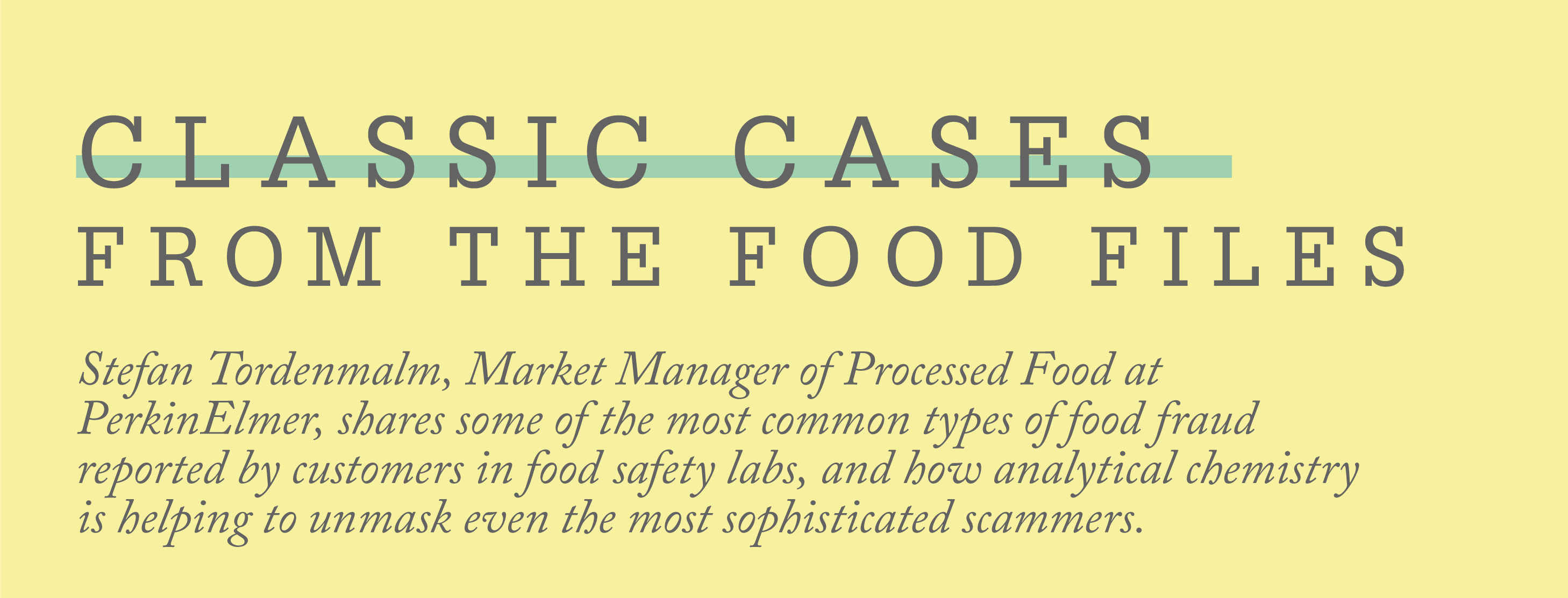
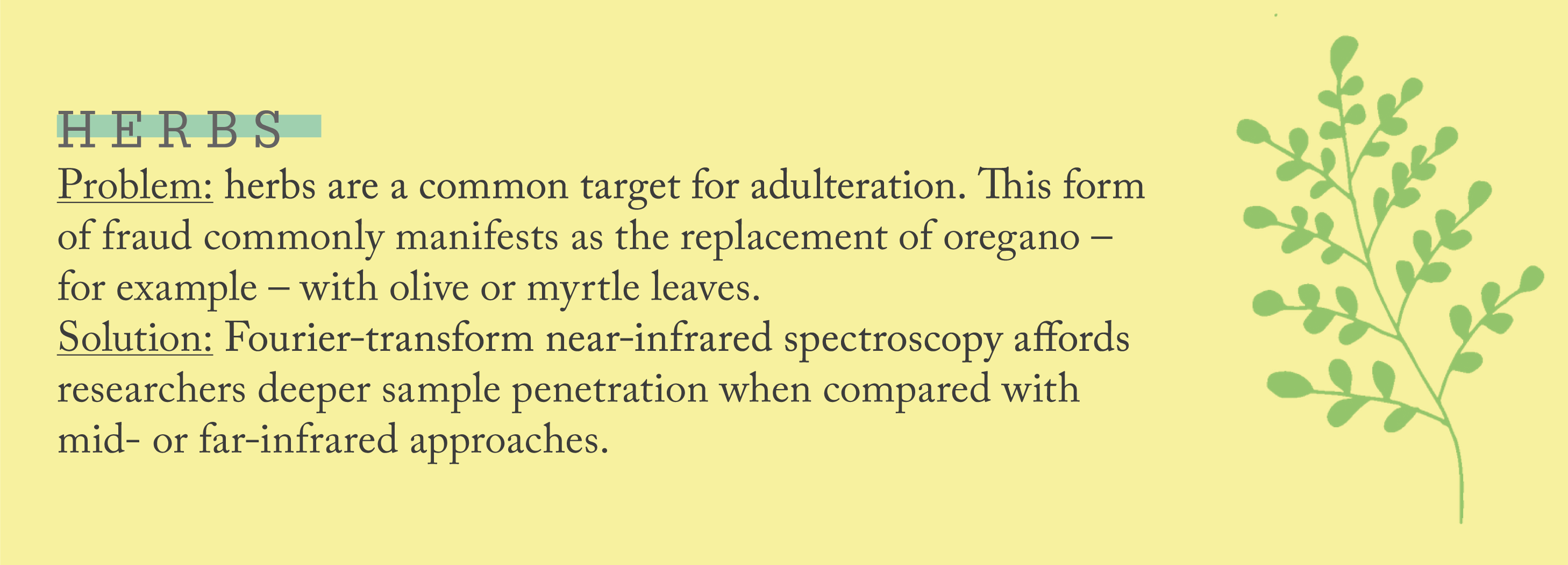
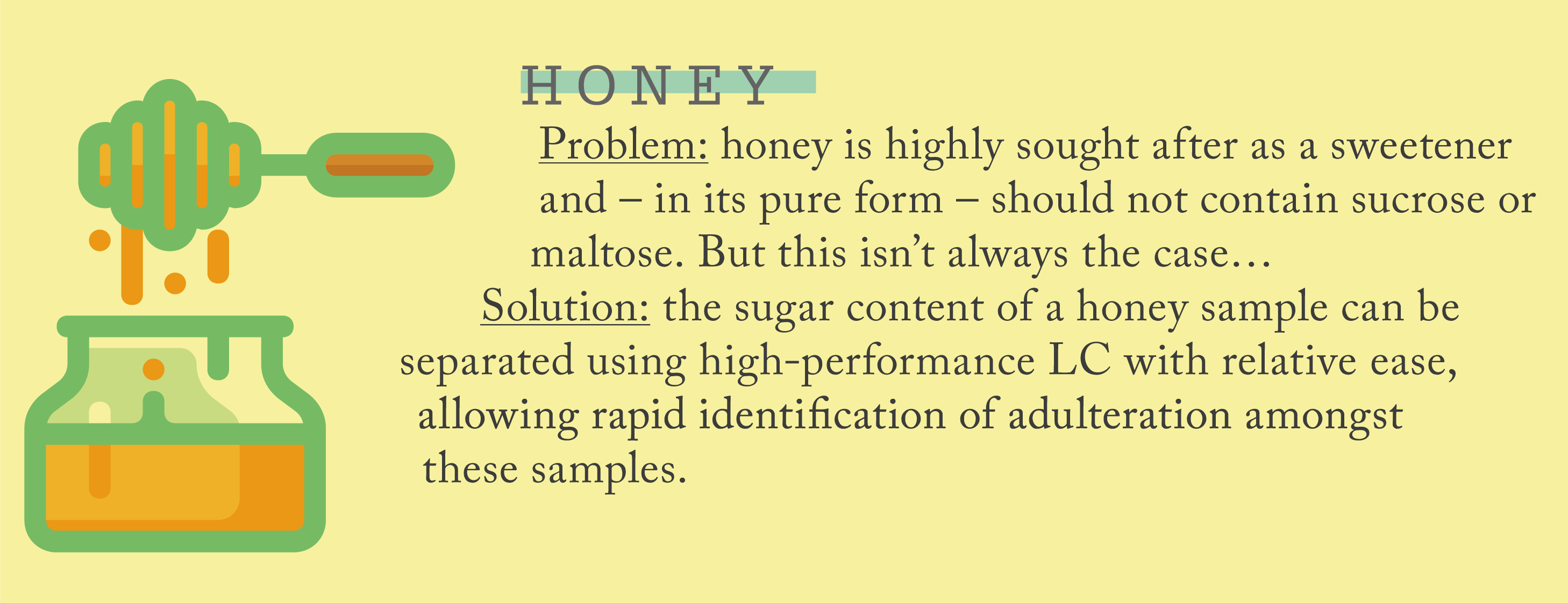
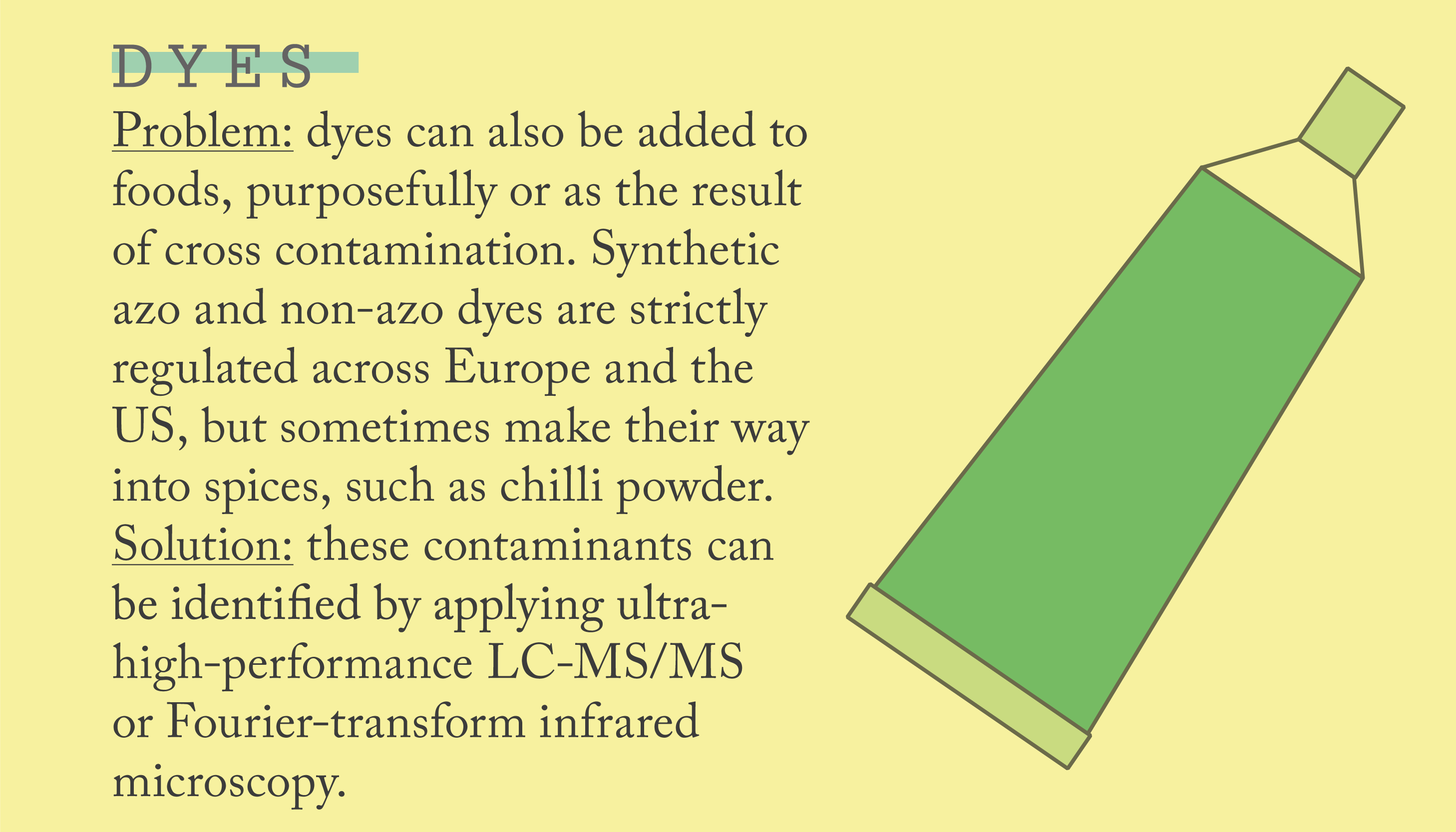
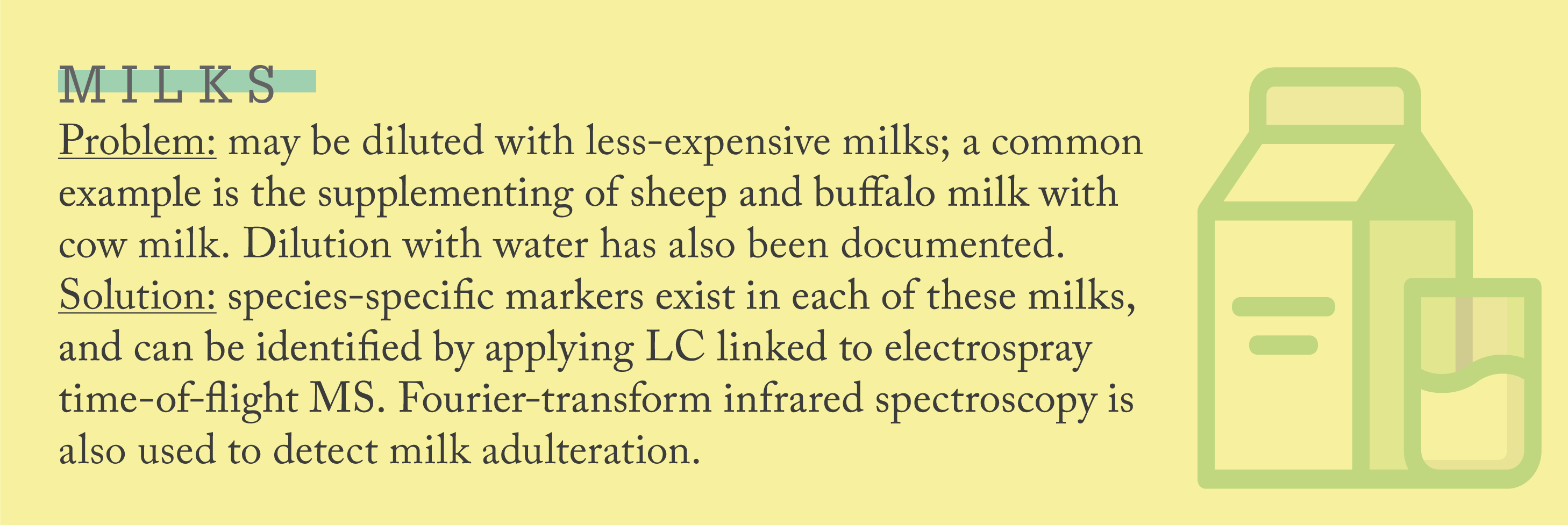
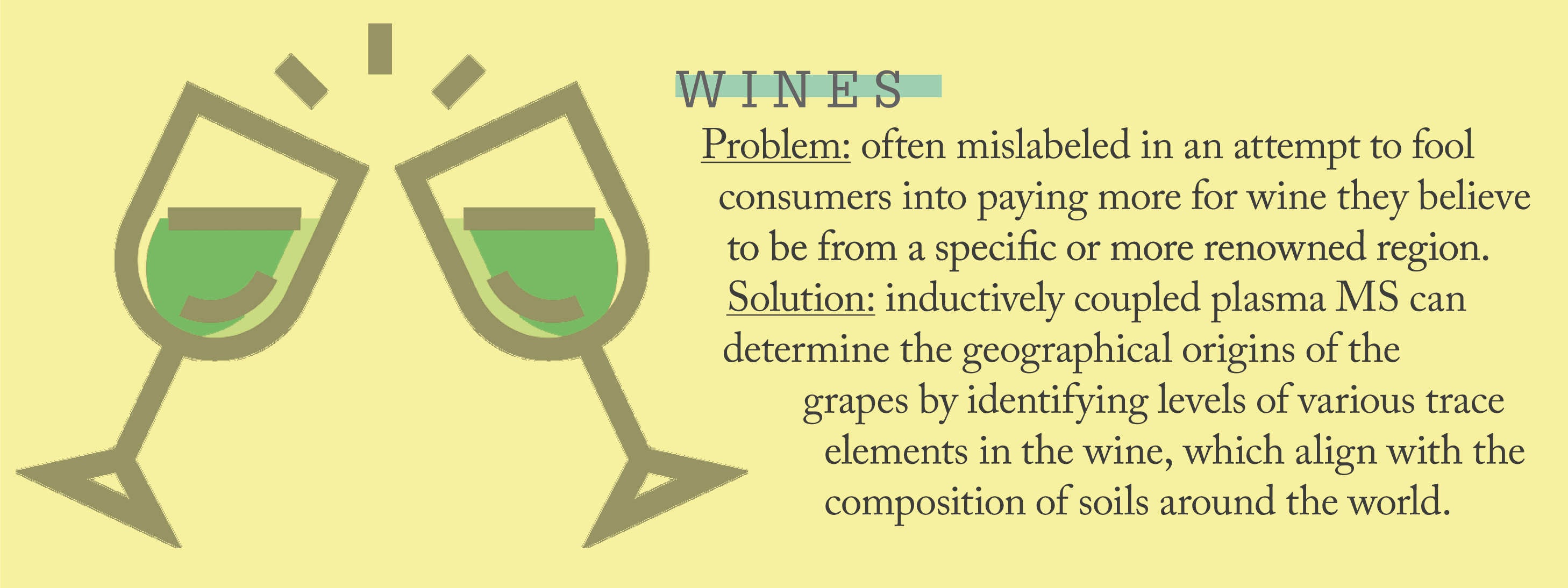
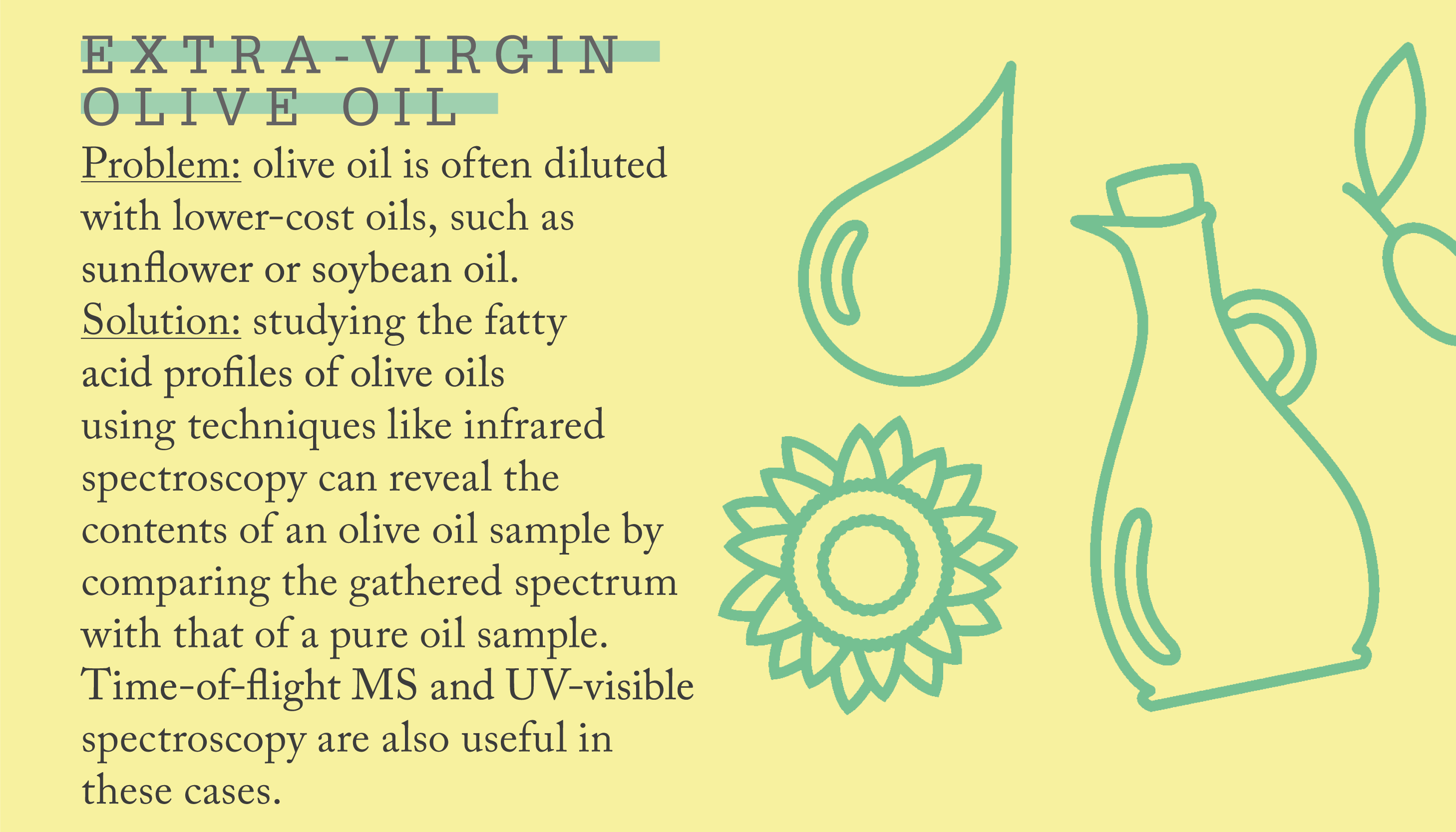
GC and LC (in particular, high-performance LC) play central roles in the detection of fraudulent foods. LC is particularly useful for the identification of naturally-occurring chemical markers that characterize botanical materials and juices. And, as outlined above, the combination of LC or GC with one- or two-dimensional MS detection affords a powerful method for both targeted and untargeted analysis. In particular, advances in HRMS in the form of Orbitrap and time-of-flight instruments and electrospray ionization are making untargeted approaches an increasingly valuable weapon in the fight against fraud.
“Untargeted analyses do not require a preidentified target. Instead, HRMS enables researchers to use accurate-mass measurements to narrow down the range of potential answers to a small number of putative chemical entities,” explains Ann Knolhoff (the Office of Regulatory Science). “This is having a significant impact on the development of screening approaches that could identify chemical adulterants before they become widespread.” Such screening will prove key for products such as dietary supplements, which may be adulterated with pharmaceutical drugs to amplify the apparent effects of the product. With a huge variety of prescription or over-the-counter drugs used by fraudsters, untargeted analyses could save lives.
Spectroscopic approaches also play a key role – namely NMR, UV, infrared and near-infrared. The combination of these approacheswith chemometric techniques for data analysis enhances their utility. Of note, the (relatively recent) advent of cavity-ringdown spectroscopy has also reduced the cost of SCIRA, improving its accessibility for labs around the world. And, on the topic of isotopic techniques, specific isotope natural fractional NMR is making waves in the detection of suspect wines and spirits.
When asked about game-changing techniques in this space, Jonathan Deeds (the Office of Regulatory Science) highlighted the significant impact of DNA analysis. “Detecting fish species substitution (for example, selling farm-raised Asian catfish as wild-caught grouper) was heavily reliant on outdated protein electrophoresis, but we can now apply DNA-based techniques such as DNA barcoding for species identification,” Jonathan explains. “The FDA has thus adopted this approach for identifying species substitution. We have applied this technique in investigations of octopus substitution with lower-priced and more easily obtained jumbo squid, and also the substitution of domestic blue crab with meat from lower value swimming crabs.”
The approach is also applicable to plant-based samples. “With plants, we witnessed an initial focus on chloroplast sequencing and identification within these sequences, but movement towards genome skimming (a next-generation sequencing method that targets portions of the entire genome) is helping the community identify plant substitution much more efficiently,” says Sara Handy (the Office of Regulatory Science).
Looking forward, the FDA is using every weapon at its disposal in the fight on food fraud – including recalls, seizures, injunctions and import refusals when warranted. Import alerts represent a valuable tool on this front and firms who trigger an import alert (and their products) are now subject to Detention Without Physical Examination.
Analytical advances are another key pillar of the FDA’s strategy. As John says: “Food is a complex matrix, and there is seldom one method or technique that can single-handedly characterize every aspect of a sample.” The solution? “Methods that integrate multiple approaches to provide full fingerprints of food will likely represent a major focus.” This will likely constitute combining broad screening approaches like NMR with untargeted HRMS or inductively coupled plasma-MS to give total profiles of food products. Advances in targeted screening, DNA analysis, chromatographic separations, and MS and NMR libraries will also be crucial.
“The development of portable devices to move methods out of labs and towards processing plants and docks would also make a huge difference, as would advances in automated sample preparation technologies,” says John. Robotics approaches could facilitate greatly improved sample throughput, and portable devices could even allow consumers to assess the safety of food products in shops and markets. One thing is for sure: scientists working in this field will be kept busy.
Indeed, analytical chemists across the globe are hard at work to put consumers’ minds at rest. Between new international alliances like the EU-China-Safe project and ever-growing collaborative databases to track confirmed cases of fraud, our defensive arsenal grows each day. And, with the European Commission Knowledge Centre for Food Fraud and Quality outlining such databases as critical for future success (alongside early warning systems and the creation of centers of competence), it would seem we are taking confident strides towards improved food safety.
But there is no place for complacency, with experts predicting a rise in food fraud as supply chains are disrupted by COVID-19 (5). When it comes to stamping out food fraud entirely, the words of Friedrich Accum seem as relevant today as when they were written in 1820: “The eager and insatiable thirst for gain, is proof against prohibitions and penalties; and the possible sacrifice of a fellow-creature's life, is a secondary consideration among unprincipled dealers.”

References
- US FDA, “Fact Sheet: FDA at a Glance” (2019). Available at: https://bit.ly/3gQP6c3
- R Johnson, “Food Fraud and ‘Economically Motivated Adulteration’ of Food and Food Ingredients,” the Congressional Research Service (2014). Available at: https://bit.ly/3kkY7MQ
- World Health Organization, “Melamine and Cyanuric acid: Toxicity, Preliminary Risk Assessment and Guidance on Levels in Food” (2008). Available at: https://bit.ly/31I4AsF
- S MacMahon et al., “A liquid chromatography–tandem mass spectrometry method for the detection of economically motivated adulteration in protein-containing foods,” J Chrom A, 1220 (2012). DOI: 10.1016/j.chroma.2011.11.066
- Europol, “Viral marketing – counterfeits, substandard goods and intellectual property crime in the COVID-19 pandemic” (2020). Available at: https://bit.ly/3gQe2jP




